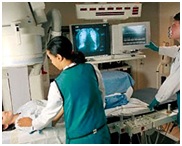LASIK Procedure - Advanced Laser Technology
LASIK - (Laser Assisted In Situ Keratomileusis) is a surgical procedure that permanently changes the shape of the cornea. The cornea is a clear covering in front of the eye that helps focus light to create an image on the retina.
LASIK Procedure
It works much like a camera lens focusing light to create an image on film. The shape of the cornea and the eye are not always perfect and sometimes the image created may be blurred or distorted. These defects are called refractive errors. The predominant refractive errors are myopia, hyperopia and astigmatism. Glasses and contact lenses are prescribed to correct these errors in people with vision problems. Refractive surgery aims at improving the eye's focusing power.
In general, the procedure of LASIK surgery is as follows:
- A flap in the cornea is cut using a knife called a microkeratome.
- The flap is folded back to reveal the stroma, leaving a hinge at one end of the flap. The stroma is the middle section of the cornea.
- Pulses from a computer-controlled laser vaporize a portion of the stroma and the flap is replaced.
Advanced Laser Technology
Laser technology has increased the hopes of finding a solution to the problem of nuclear waste. A giant laser has found to reduce the toxicity of nuclear waste by a factor of 100. Advanced Laser technology has its applications in various fields like industry, scientific research, communications, medicine, military applications, etc.
Laser technology in industry has many uses like drilling holes in diamonds, alignment in construction work, etc. In scientific research, it is used for accurate measurements and particle accelerators, etc. Advanced Laser technology is useful in space communications. Laser technology is used in surgical procedures. Advanced Laser technology is used to build guidance systems for aircrafts, missiles and satellites.
Medical Technology

Recent advances in medical technology have paved the way for better health and improved Scientists have found that by injecting magnetic nanoparticles into the bloodstream, the precise location of harmful viruses can be determined. These magnetic nanoparticles are coated with antibodies to a specific virus. If the virus were present, it would form clumps, which would then be visible in a normal body scan. Such scans that reveal where the virus are may help doctors improve treatments.
